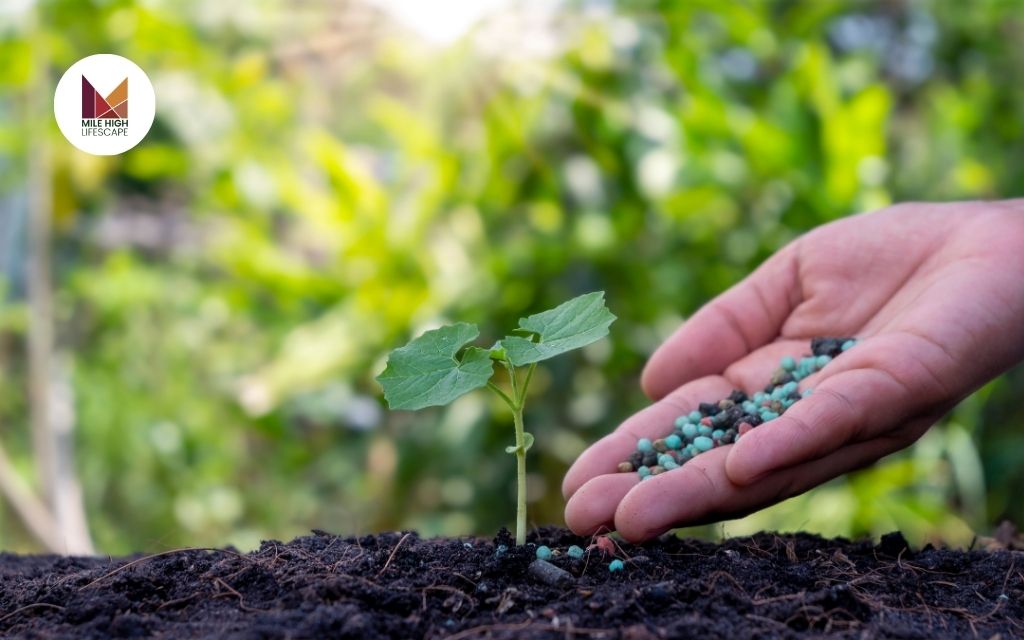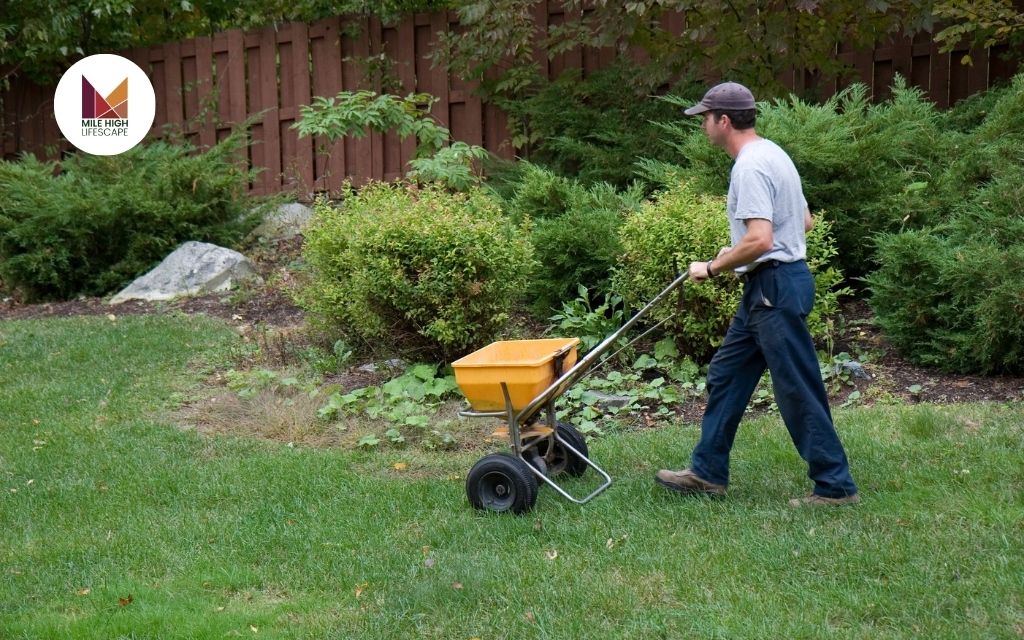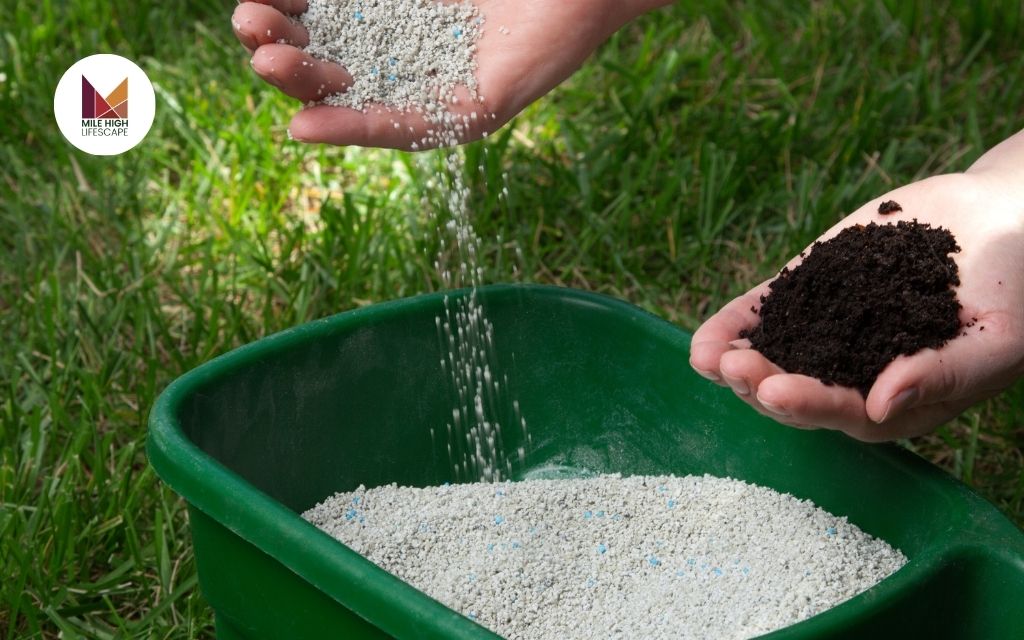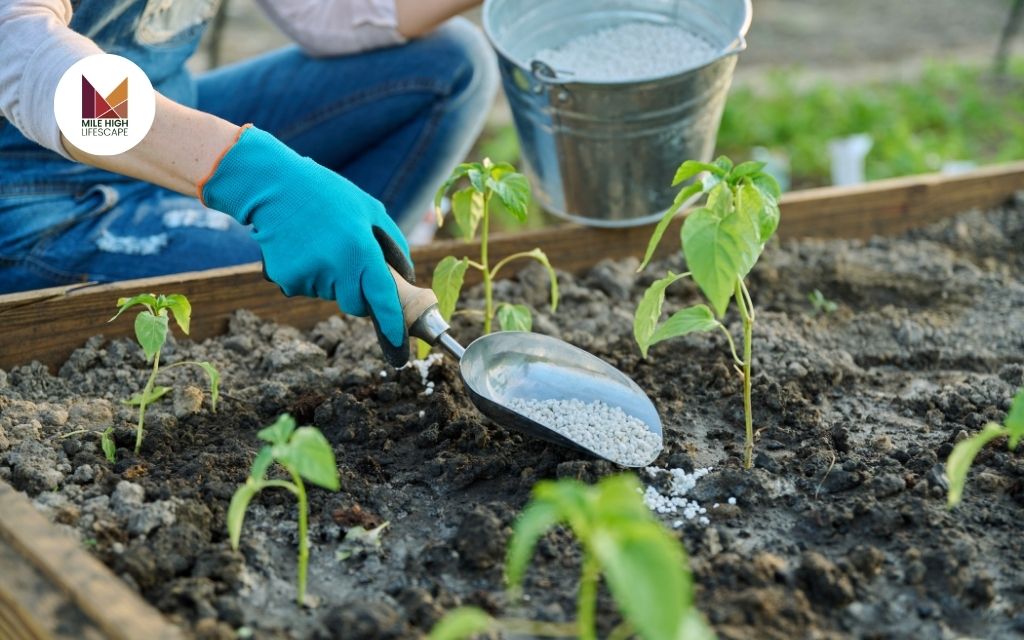A lush, green lawn is the pride of any homeowner, and the secret to achieving it lies in using the right lawn fertilizer. Fertilizer provides essential nutrients that promote healthy growth, improve resilience, and give your grass that vibrant, enviable color. But with so many options available, choosing the right type and applying it correctly can feel overwhelming.
From organic blends to quick-release formulas, each fertilizer offers unique benefits tailored to different lawn care needs. Understanding when and how to apply fertilizer ensures your lawn gets exactly what it needs to thrive.
For those in Mile High seeking expert guidance, Mile High Lifescape is the trusted name in professional tree and lawn care. Their team helps you select and apply the best fertilizers for a healthy, beautiful yard. Ready to take your lawn to the next level? Let’s explore the essentials of lawn fertilizer!
What Is a Lawn Fertilizer?
Lawn fertilizer is a product that helps your grass grow healthy and strong by adding extra nutrients to the soil. It has three main nutrients that plants love:
- Nitrogen (N): Helps grass grow green and leafy.
- Phosphorus (P): Supports strong root growth and helps seeds develop.
- Potassium (K): Boosts plant strength and helps protect against diseases.
The numbers on a fertilizer bag (like 18-3-6) show how much of each nutrient is in the mix. For example, an 18-3-6 fertilizer has 18% nitrogen, 3% phosphorus, and 6% potassium.
Different fertilizers can be made for different needs:
- High-Nitrogen Fertilizers: Perfect for making your grass green and full of life.
- Balanced Fertilizers: Give your grass a good mix of all three nutrients.
- Specialty Fertilizers: Help with specific problems like weeds or pests.
You can also choose between organic fertilizers (like compost or manure) and synthetic fertilizers (like ammonium sulfate). Both types can help your lawn thrive!

Benefits of Using Lawn Fertilizer
Fertilizing your lawn is a smart way to take care of your yard, but you might wonder if it’s really worth the time and money. Here’s how lawn fertilizer can help your grass grow healthier and stronger:
Weed Prevention
Many fertilizers also help control weeds. Even if they don’t have weed-prevention ingredients, they help your grass grow thick and healthy. Strong, thick grass with deep roots is less likely to be taken over by weeds.
Better Protection Against Disease
Have you ever noticed parts of your lawn turning brown or dying suddenly? This is often caused by diseases that attack the grass at the roots. When your grass gets the right nutrients, it grows stronger and is less likely to get sick.
Improved Growth Everywhere
Have you ever had some parts of your lawn that are thick and green, but others are thin and patchy? This is usually because some areas aren’t getting enough nutrients. Lawn fertilizer helps the whole yard grow evenly, so you can have a lush and beautiful lawn throughout.

Soil Protection
Grass needs nutrients from the soil to grow strong and healthy. When you fertilize your lawn, it grows thick, which helps prevent soil from washing away during rain. Fertilized soil also stays healthier longer, even after storms. This means that by taking care of your soil today, you’re helping your lawn stay strong for years to come.
Pest Resistance
A lawn that’s well-fed with fertilizer is stronger and more able to fight off pests. Even if your fertilizer doesn’t have insecticides, thick grass makes it harder for pests to cause problems. The healthier your lawn, the less likely pests will take over.
Types of Lawn Fertilizers
Synthetic Fertilizers
Synthetic fertilizers are made from chemicals and contain nutrients like nitrogen, phosphorus, and potassium. They are easy to find and usually cost less. These fertilizers work fast and can quickly make your grass greener. But, since they are chemical-based, it’s important to use them correctly to avoid harming your grass. Always follow the instructions on the label.
The lawn fertilizer packaging will list an NPK ratio, which shows the percentage of nitrogen, phosphorus, and potassium in the mix. For example, a 20-5-10 fertilizer has 20% nitrogen, 5% phosphorus, and 10% potassium. Many synthetic fertilizers also contain other helpful nutrients like iron, zinc, and copper.
Nitrogen-Based Fertilizers
Nitrogen helps grass turn green, grow strong leaves, and develop better roots. Nitrogen fertilizers come in different types, such as quick-release, slow-release, and controlled-release, so you can pick the one that best matches your lawn’s needs. Nitrogen is the most important part of any fertilizer, and it’s key for getting that lush, green look.
Phosphate-Based Fertilizers
These fertilizers have more phosphorus, which helps roots grow deep and strong. They’re especially good for new lawns or lawns with poor soil. Phosphate fertilizers help your grass establish a strong root system and fight off diseases and pests.
Potassium-Based Fertilizers
Potassium helps your grass handle tough weather like heat or drought. This type of fertilizer is great if your lawn has been damaged or if it needs help bouncing back from stress. Potassium makes your grass more resilient and improves its overall health by making the plant cells stronger.
Organic Fertilizers
Organic fertilizers are made from natural materials like plants and animals. They are often called “natural fertilizers” because they are kind to the environment. These fertilizers release nutrients slowly into the soil, which helps your lawn over time.
While they don’t give quick results like synthetic fertilizers, they are better for long-term soil health. This means your grass will be healthier in the future.
Here are a few examples of ingredients commonly found in organic fertilizers:
- Manure
- Compost
- Bone Meal
- Alfalfa Meal
- Corn Gluten Meal
- Egg Shells
- Rock Phosphate
- Kelp
By using organic fertilizers, you’re helping your lawn stay healthy and strong in a natural way!

Liquid & Fast-Acting Fertilizers
Liquid fertilizers are a type of plant food that come in a liquid form, making them easy to apply and quick for your grass to absorb. Some liquid fertilizers come as concentrates, which you mix with water before using them on your lawn.
One great thing about liquid fertilizers is that they work fast, giving you quick results. They’re also perfect for treating specific areas of your lawn or using a hose-end sprayer.
However, liquid fertilizers can evaporate in the hot sun, and if it rains right after you apply them, they might wash away before they can be absorbed by the grass. To make sure your fertilizer works best, apply it on a dry day and aim for late afternoon, when the temperature is cooler and there’s less chance of rain. This will help your lawn get the most out of the fertilizer!
Granular & Slow-Release Fertilizers
Granular fertilizers are dry, pellet-like granules that you spread on top of the soil and then water in. As the pellets break down slowly, they release nutrients little by little into the soil. This steady release of nutrients is great for your lawn’s long-term health.
While you won’t see fast results like with liquid fertilizers, it’s important to be patient and give your lawn time to improve. The good thing about granular fertilizers is that they’re easy to store and last a long time, so they’re a great choice for keeping your lawn healthy over the long run!
Choosing the Right Lawn Fertilizer
Understanding Your Soil
Before selecting a fertilizer, it’s essential to understand your soil’s composition. Conducting a soil test reveals nutrient deficiencies and pH levels, guiding you to choose a fertilizer that addresses your lawn’s specific requirements. Soil testing kits are available for DIY use, or you can consult local extension services for a comprehensive analysis.
Matching Fertilizer to Grass Type
Different grass types have unique nutrient needs:
- Cool-Season Grasses: Varieties like Kentucky bluegrass and fescue thrive in cooler climates and benefit from fertilizers higher in nitrogen, especially during their peak growth periods in spring and fall.
- Warm-Season Grasses: Species such as Bermuda and zoysia prefer warmer temperatures and may require fertilizers with balanced nutrient ratios during their active growing season in late spring and summer.
Identifying your grass type ensures you select a fertilizer that supports optimal growth.

Considering Seasonal Needs
Timing fertilizer applications to the growing season enhances lawn health:
- Spring: Apply a balanced fertilizer to support new growth as your lawn emerges from dormancy.
- Summer: Use a slow-release fertilizer to maintain vigor during heat and potential drought conditions.
- Fall: Fertilize with a product higher in potassium to strengthen roots and prepare the lawn for winter.
Adjusting fertilizer types and application timing according to the season promotes a resilient and vibrant lawn year-round.
How to Apply Lawn Fertilizer
Now that you know the basics of lawn fertilizing, it’s time to get your lawn looking great! Here are some easy steps to follow:
- Pick the right fertilizer – Make sure you choose a fertilizer that’s perfect for your type of grass.
- Spread it evenly – Use a fertilizer spreader to make sure the fertilizer is spread evenly across your lawn.
- Water it well – After applying the fertilizer, water the area thoroughly to help the nutrients reach the roots of your grass.
- Fertilize regularly – To keep your lawn healthy, make sure to fertilize it regularly for the best results.
Want a Green, Lush Lawn? Contact Mile High Lifescape Now
Mile High Lifescape is Denver’s top choice for lawn care, focused on turning your yard into a beautiful, healthy, and thriving space. With over 20 years of experience, our team offers a range of services designed just for your lawn’s needs, helping it stay vibrant and strong.
From careful mowing and trimming to lawn fertilizer and weed control, we use the best methods to keep your lawn in great shape all year long. Our dedication to customer satisfaction and paying attention to every detail has made us the trusted lawn care experts in Denver.
FAQs about Lawn Fertilizer
What is best to fertilize lawn?
The best fertilizers for lawns are those that provide a balanced mix of essential nutrients. For instance, Espoma EOLB30 Organic Spring Lawn Booster Fertilizer is highly recommended for its effectiveness in promoting healthy grass growth.
What is lawn food?
Lawn food is a type of fertilizer specifically formulated to provide essential nutrients like nitrogen, phosphorus, and potassium to grass, promoting healthy growth and a vibrant green appearance.
What is lawn feed?
Lawn feed is another term for lawn fertilizer; it supplies the necessary nutrients to the soil to support grass health and growth. Products labeled as lawn feed typically contain a mix of nitrogen, phosphorus, and potassium.
Conclusion
Lawn fertilizer is the secret to a beautiful, healthy lawn. It helps your grass grow stronger, greener, and more resilient, turning your yard into a lush oasis. Whether you use organic or synthetic fertilizer, applying it correctly ensures your lawn gets the nutrients it needs to thrive.
If you’re unsure where to start, Mile High Lifescape is here to help with expert lawn care services tailored to your yard’s needs. Let us guide you to achieve the lush, green lawn you’ve always dreamed of!







